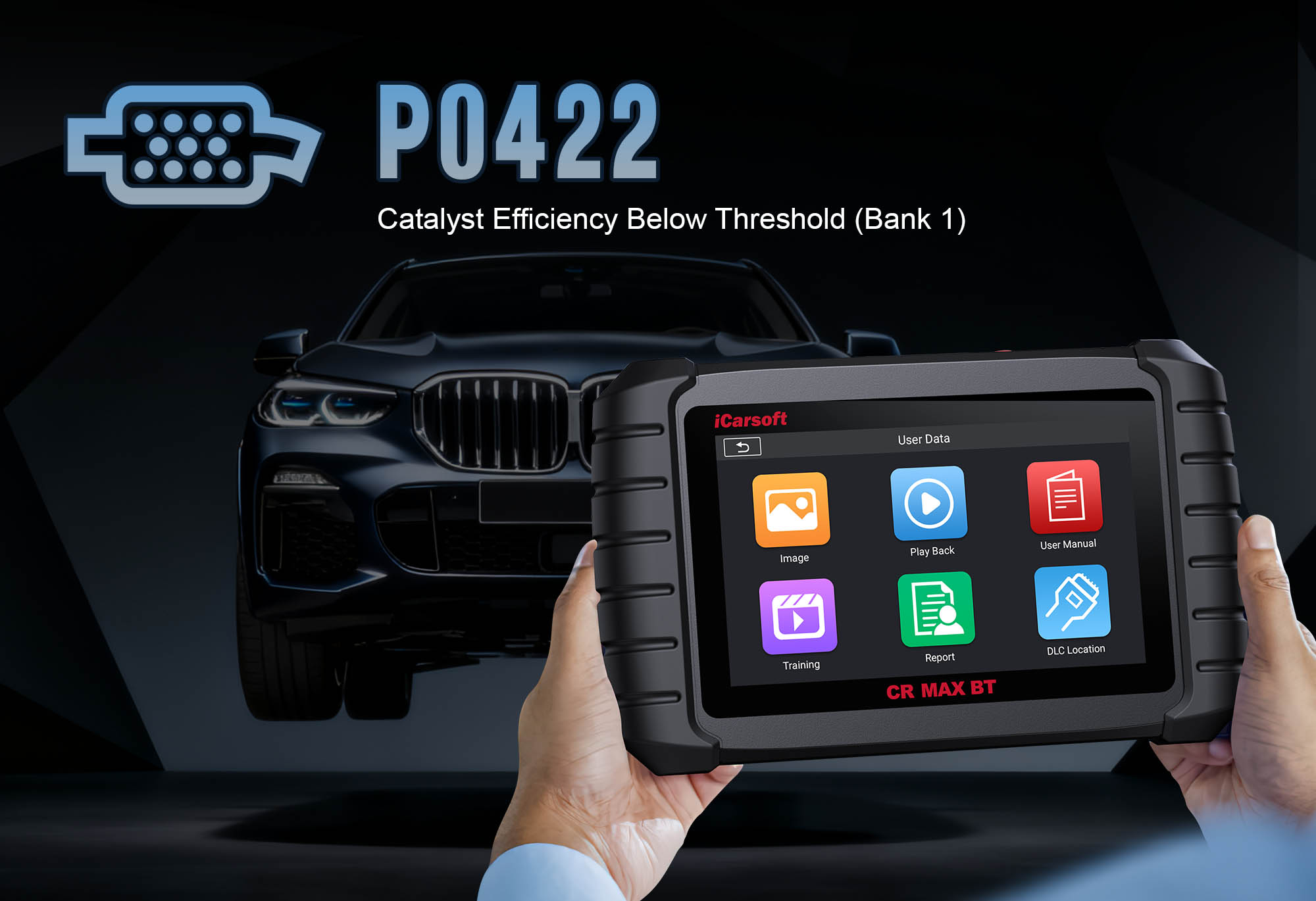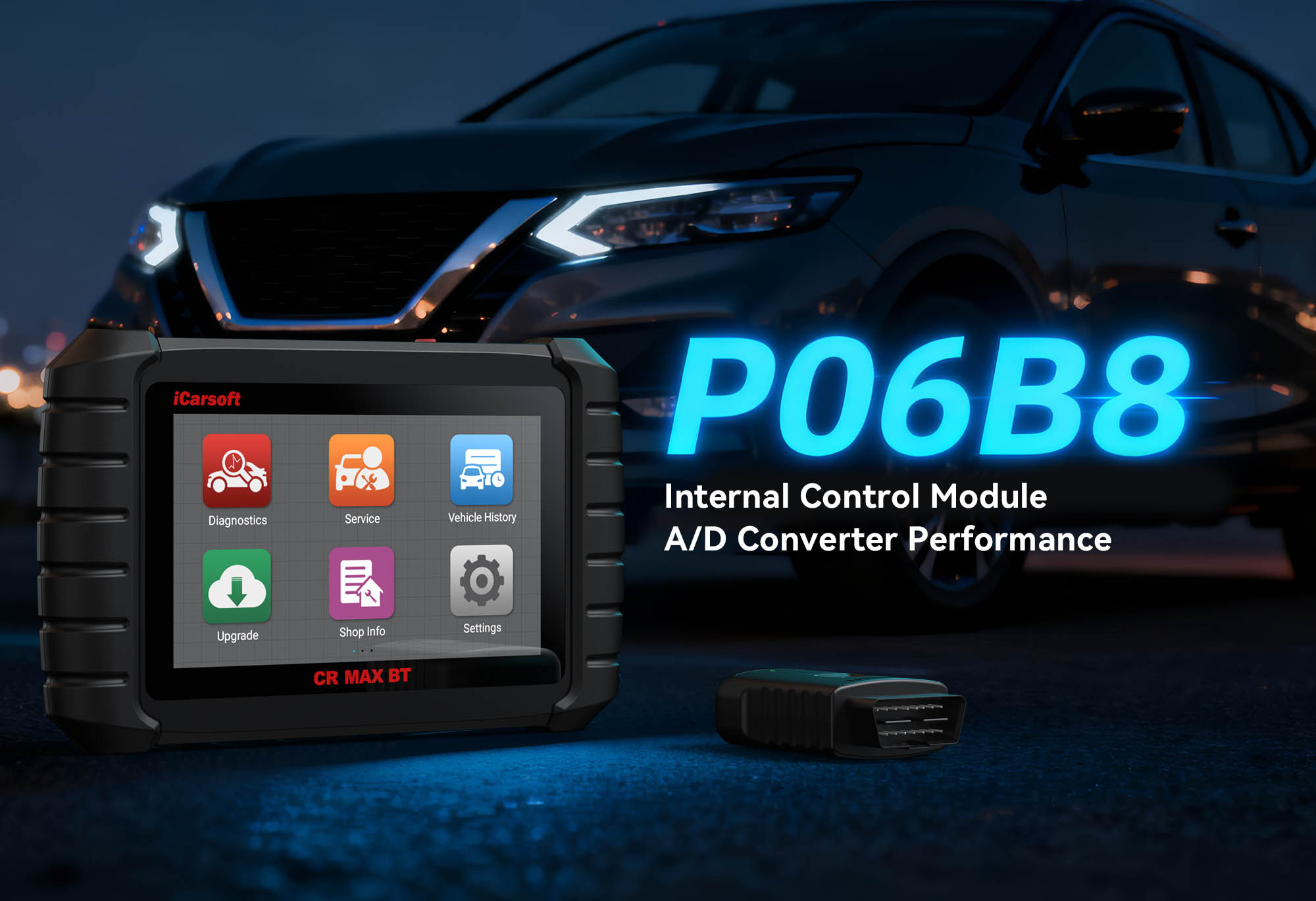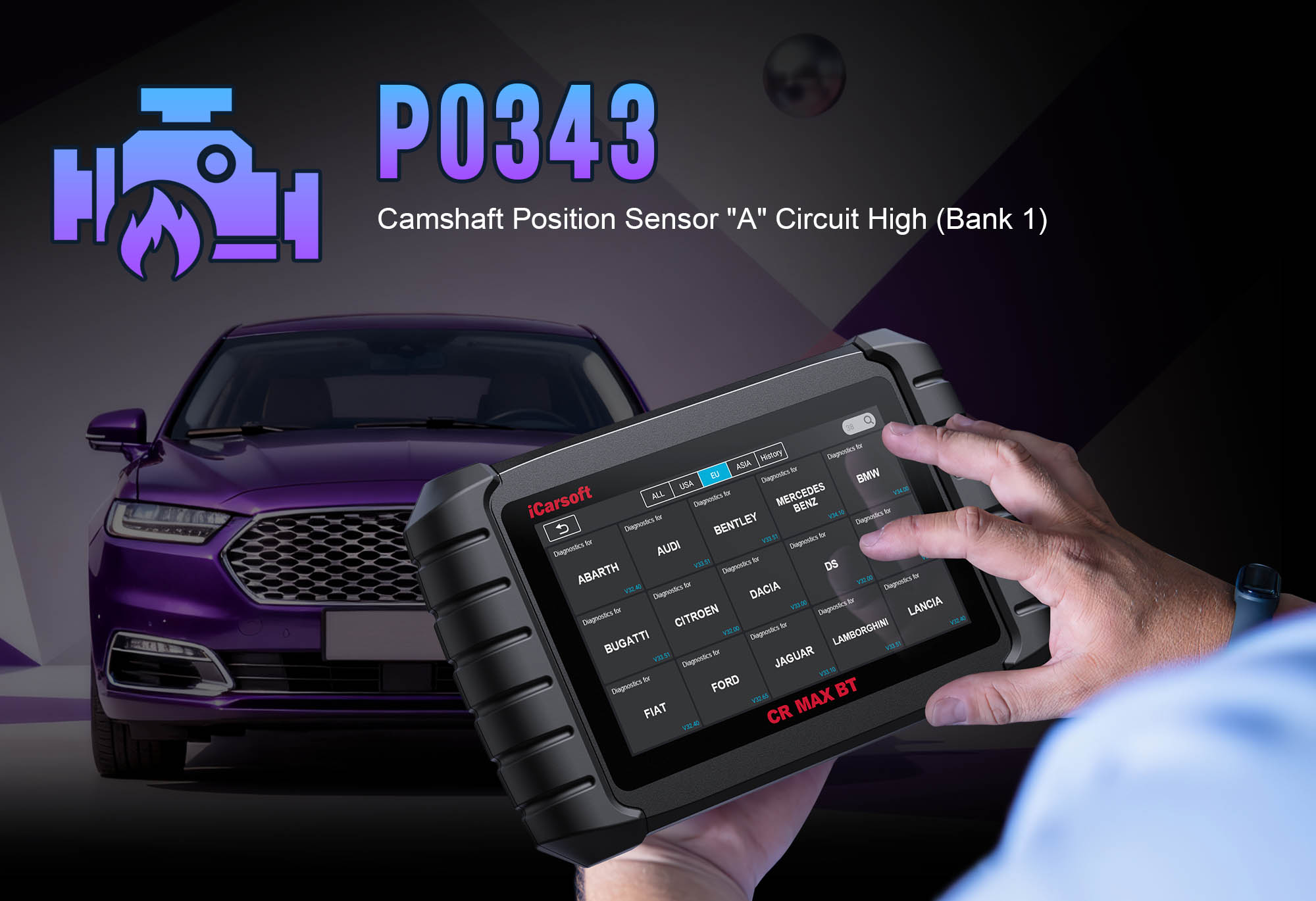Understand & Fix P0422: Catalytic Converter Efficiency Below Threshold with iCarsoft CR MAX BT
If your vehicle’s Check Engine Light (CEL) stays on, you notice a rotten egg smell from the exhaust, or it fails an emissions test, a diagnostic scan will likely return P0422. This critical OBD-II code signals "Catalytic Converter Efficiency Below Threshold (Bank 1)"—meaning the catalytic converter (CAT) is no longer effectively reducing harmful emissions like carbon monoxide (CO) and hydrocarbons (HC). While a failing CAT might seem like a costly fix, misdiagnosing P0422 can lead to unnecessary converter replacements (costing $800–$2,500) when the issue is a faulty oxygen sensor or exhaust leak.
Basic code readers can only confirm "P0422 is present" but can’t distinguish between a bad CAT, damaged O2 sensor, or exhaust leak. The iCarsoft CR MAX BT changes this. As a professional-grade wireless diagnostic tool, it offers OE-level emissions testing, live O2 sensor data, and compatibility with 58+ vehicle brands—making it the ideal solution for resolving P0422 in popular models like the Ford F-150, Chevrolet Silverado, and Toyota Camry. Let’s break down everything you need to fix P0422 confidently.
 iCarsoft CR MAX BT monitoring O2 sensor data to diagnose P0422 catalytic converter issues
iCarsoft CR MAX BT monitoring O2 sensor data to diagnose P0422 catalytic converter issues
What Exactly Is the P0422 Code?
P0422 targets the catalytic converter on Bank 1 (the cylinder bank containing the #1 cylinder). The CAT’s job is to convert 90%+ of harmful exhaust gases into less toxic compounds (e.g., CO₂ and water) using a catalyst (platinum, palladium, rhodium). To monitor efficiency, the ECM uses two oxygen (O2) sensors: one before the CAT (upstream) and one after (downstream).
Under normal conditions, the upstream O2 sensor reads fluctuating oxygen levels (0.1V–0.9V) from unburned fuel, while the downstream sensor reads stable, low-oxygen levels (0.4V–0.6V) from the cleaned exhaust. When the CAT fails, the downstream sensor’s readings mirror the upstream sensor’s—indicating the CAT isn’t filtering emissions. The ECM then logs P0422. This code is common in high-mileage vehicles (100,000+ miles) or those with fuel system issues, but the iCarsoft CR MAX BT pinpoints the exact cause with vehicle-specific data.
Key Symptoms of the P0422 Code
P0422 often progresses slowly, but these symptoms signal a failing CAT or related issue:
-
Illuminated Check Engine Light (CEL): The primary indicator, often paired with an "Emissions System Fault" message on modern dashboards (critical for California P0422 compliance).
-
Rotten Egg Smell: A strong sulfur odor from the exhaust—caused by unfiltered hydrogen sulfide (common in high-mileage P0422 vehicles).
-
Reduced Fuel Efficiency: A failing CAT creates exhaust backpressure, forcing the engine to work harder—leading to 10–15% higher fuel consumption.
-
Failed Emissions Test: High HC/CO levels will cause a failed smog check—mandatory for vehicle registration in most states.
-
Loss of Power: Severe backpressure can reduce acceleration, especially at high RPMs (noticeable in Ford F-150 P0422 towing scenarios).
Common Causes of the P0422 Code
P0422 doesn’t always mean a bad CAT—here are the most likely culprits, ordered by frequency:
|
Cause
|
Description
|
|
Faulty Downstream O2 Sensor
|
A damaged sensor sends false "low efficiency" signals to the ECM—top cause of false P0422 codes (costs $120–$250 to replace, vs. $800+ for a CAT).
|
|
Exhaust Leak
|
Leaks before the downstream O2 sensor draw in fresh air, making the sensor think the CAT is failing (common in Chevrolet Silverado P0422 with rusted exhaust pipes).
|
|
Failing Catalytic Converter
|
Thermal damage, fuel contamination, or normal wear reduces catalyst effectiveness—common in vehicles with 150,000+ miles or misfire-related P0422.
|
|
Fuel System Issues
|
Rich fuel mixture (too much fuel, too little air) floods the CAT with unburned fuel, damaging the catalyst (caused by faulty fuel injectors or mass airflow sensor).
|
|
ECM Software Glitch
|
Outdated firmware misinterprets O2 sensor data—fixable with the CR MAX BT’s One-Key Upgrade function.
|
Why iCarsoft CR MAX BT Excels at Diagnosing P0422
Resolving P0422 requires testing the CAT, O2 sensors, and exhaust system—something basic scanners can’t do. The CR MAX BT stands out with features tailored to emissions-related faults:
Wireless O2 Sensor Data Tracking
Monitor upstream/downstream O2 sensor voltage in real time from 30+ feet away—spot "mirrored" readings (the P0422 red flag) in seconds.
Catalytic Converter Efficiency Test
Run a built-in OE-level test to measure the CAT’s conversion rate—avoids unnecessary replacements by confirming if the CAT is truly failing.
Auto VIN Identification
Automatically detect your vehicle’s make, model, and exhaust layout (e.g., single vs. dual CAT for Ford F-150) for accurate diagnostics.
Exhaust System Leak Detection
Use live data to check for sudden O2 sensor spikes—indicative of air leaks in the exhaust manifold or pipes.
58-Brand Compatibility
Works with all makes prone to P0422, from domestic trucks (Chevrolet Silverado) to import cars (Toyota Camry) and luxury models (BMW).
Free Lifetime Updates
Ensure compatibility with 2024+ models and new emissions regulations—critical for resolving California P0422 compliance issues.
Step-by-Step: Diagnose & Fix P0422 with iCarsoft CR MAX BT
-
1. Confirm P0422 & Gather Vehicle-Specific Data
1. Plug the CR MAX BT’s OBD-II adapter into your vehicle’s port and pair via Bluetooth (the 7-inch touchscreen connects in 10 seconds).
2. Select Auto VIN Identify to pull your vehicle’s specs, then navigate to Engine > Fault Codes > Read Codes to confirm P0422.
3. Tap Code Details for insights—e.g., "Toyota Camry: P0422 CAT Efficiency Low; Downstream O2 Voltage: 0.8V (Upstream: 0.8V); Check Sensor/Leak."
-
2. Analyze O2 Sensor Data to Rule Out False Codes
Go to Engine > Live Data > Oxygen Sensors and run the engine at 2,000 RPM for 5 minutes. Monitor these key metrics:
- Upstream vs. Downstream Voltage: Normal = upstream fluctuates (0.1V–0.9V), downstream stable (0.4V–0.6V). Mirrored readings = P0422 trigger.
- Sensor Response Time: Upstream should respond to throttle changes in 100–200ms. Slow response = faulty sensor (common in Chevrolet Silverado P0422).
-
3. Test for Exhaust Leaks
1. Use the CR MAX BT’s Exhaust Leak Test function (under Emissions System).
2. With the engine off, spray soapy water on exhaust joints (manifold, pipes, CAT connections) and run the test.
3. Bubbles = leak—repair with exhaust sealant or replace the damaged section.
-
4. Run the CAT Efficiency Test
1. Navigate to Engine > Special Functions > CAT Efficiency Test.
2. The CR MAX BT will measure the CAT’s conversion rate over 10 minutes.
3. A result below 70% = failing CAT; above 70% = issue is sensor/leak.
-
5. Repair & Validate the Fix
1. Fix based on results: Replace a faulty O2 sensor, repair exhaust leaks, or address fuel system issues (use the CR MAX BT’s Fuel Injector Test to check for leaks).
2. For a failing CAT, use an OEM or CARB-compliant replacement (critical for California).
3. Clear P0422 via Fault Codes > Clear Codes, then drive 100+ miles to complete the ECM’s readiness monitors.
4. Re-scan with the CR MAX BT—stable downstream O2 sensor voltage and a passing CAT efficiency test confirm the issue is resolved.
FAQs: Your P0422 Questions Answered
Q: Is it safe to drive with the P0422 code?
A: Short trips are okay, but long-term driving risks: 1) Failed emissions tests (blocking registration); 2) Exhaust backpressure damaging the engine; 3) Increased pollution. Fix P0422 promptly.
Q: How much does it cost to fix P0422?
A: Costs vary: O2 sensor replacement = $120–$250; exhaust leak repair = $80–$200; CAT replacement = $800–$2,500 (OEM). The CR MAX BT saves $100+ on diagnostics and avoids unnecessary CAT swaps.
Q: Why does P0422 come back after O2 sensor replacement?
A: You missed a hidden issue: exhaust leak, fuel system problem, or a truly failing CAT. Use the CR MAX BT’s CAT efficiency test and exhaust leak detection to find the root cause.
Q: Will a "CAT cleaner" fix P0422?
A: Only if the issue is mild carbon buildup (rare). CAT cleaners won’t fix a damaged catalyst, faulty sensor, or exhaust leak. Use the CR MAX BT to diagnose first—avoid wasting money on additives.
Q: Does P0422 affect diesel vehicles?
A: Yes—diesel trucks (e.g., Chevrolet Silverado Duramax) use diesel particulate filters (DPFs) and catalysts. The CR MAX BT’s diesel-specific diagnostics handle diesel P0422 cases.
Q: Can a misfire cause P0422?
A: Absolutely—unburned fuel from misfires damages the CAT’s catalyst. Use the CR MAX BT’s Misfire Detection to check for cylinder misfires before replacing the CAT.
Conclusion
The P0422 code’s "catalytic converter efficiency low" message is intimidating, but misdiagnosing it doesn’t have to be. The iCarsoft CR MAX BT simplifies diagnostics with wireless O2 sensor tracking, CAT efficiency tests, and vehicle-specific insights—whether you’re fixing a Toyota Camry or Ford F-150.
Don’t let P0422 cost you thousands in unnecessary CAT replacements or block your vehicle registration. Invest in the CR MAX BT today to diagnose, fix, and maintain your emissions system with professional confidence.

 iCarsoft CR MAX BT monitoring O2 sensor data to diagnose P0422 catalytic converter issues
iCarsoft CR MAX BT monitoring O2 sensor data to diagnose P0422 catalytic converter issues



